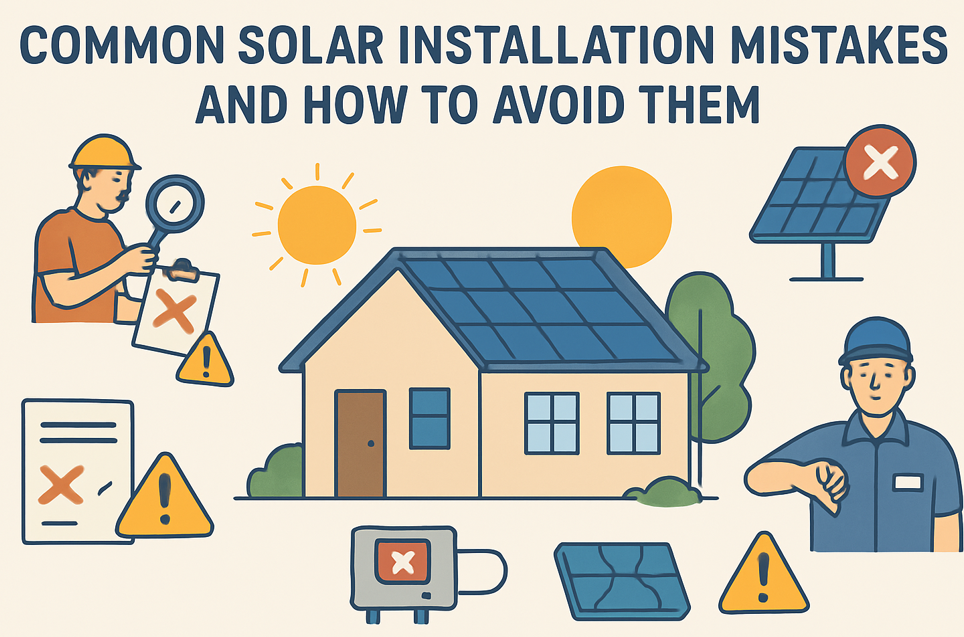Common Solar Installation Mistakes and How to Avoid Them

Installing solar panels is one of the smartest investments you can make — for both your wallet and the environment. But while solar energy can drastically reduce electricity bills and carbon footprint, the installation process is not something to take lightly. A small oversight can lead to poor performance, added costs, or even safety risks.
To help you get the most out of your solar investment, here are the most common solar installation mistakes — and practical tips on how to avoid them.
1. Skipping a Proper Site Assessment
One of the biggest mistakes homeowners make is assuming that any roof can handle solar panels. In reality, several factors determine if your property is solar-ready — such as roof angle, shading, and structural integrity.
How to Avoid It:
- Hire a professional solar installer to conduct a thorough site inspection.
- Make sure they use solar mapping tools to analyze shading and optimize panel placement.
- If your roof is old or damaged, consider repairing or replacing it before installation.
2. Choosing the Wrong System Size
Installing too few panels means you won’t produce enough energy, while installing too many may not bring extra savings if your utility doesn’t offer full net metering.
How to Avoid It:
- Review your past electricity bills to calculate your average monthly usage.
- Ask your installer to design a system that matches your real energy needs — with room for slight future growth (like an EV or new appliance).
- Use a solar calculator to estimate savings and performance before finalizing the setup.
3. Poor Panel Placement
Even high-quality solar panels won’t perform efficiently if they’re installed at the wrong angle or facing the wrong direction.
How to Avoid It:
- Tropical regions, south-facing panels often capture the most sunlight.
- Ensure there’s no shading from trees, nearby buildings, or antennas during peak sunlight hours.
- If roof installation isn’t optimal, explore ground-mounted systems or adjustable racks for maximum exposure.
4. Ignoring Local Permits and Regulations
Skipping local building codes or failing to secure permits can lead to costly fines or forced removal of your system.
How to Avoid It:
- Work only with licensed and certified solar installers who are familiar with local regulations.
- Check if your area offers solar incentives or rebates that require specific documentation.
- Always request a copy of permits and inspection results for your records.
5. Neglecting Maintenance and Monitoring
Many homeowners believe solar panels are “set it and forget it” — but even low-maintenance systems need periodic care. Dust, debris, and technical issues can lower energy output over time.
How to Avoid It:
- Clean your panels at least twice a year (more often if you live near the coast or in dusty areas).
- Use a solar monitoring app to track system performance and detect issues early.
- Schedule annual inspections with your installer to ensure everything is running efficiently.
6. Hiring Unqualified Installers
Going with the cheapest quote can be tempting, but poor workmanship often leads to wiring problems, roof leaks, or even fire hazards.
How to Avoid It:
- Always verify your installer’s credentials, certifications, and customer reviews.
- Ask for previous installation photos and references.
- Choose a company that offers a comprehensive warranty — covering both panels and installation.
7. Overlooking Inverter Quality
While solar panels get most of the attention, the inverter is what converts sunlight into usable electricity. A poor-quality inverter can bottleneck your system’s performance.
How to Avoid It:
- Invest in a reliable inverter brand with a solid warranty (usually 10–15 years).
- Consider hybrid or microinverters for better efficiency and system monitoring.
- Ask your installer to explain the inverter’s capacity and compatibility with your chosen panels.
Final Thoughts
Solar energy offers freedom, sustainability, and long-term savings — but only when installed correctly. By avoiding these common mistakes and working with experienced solar professionals, you ensure your investment pays off for decades to come.
Ready to take the next step toward cleaner, more affordable power?
Contact your trusted solar installer today and get a free assessment for your home or business.